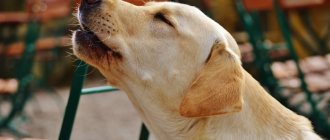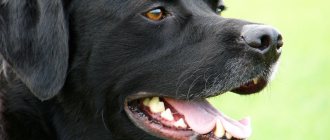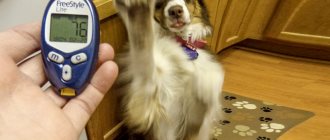If you work long or inconsistent hours, you may worry about how long you'll have to leave your dog home alone. How long can dogs go without going to the toilet?
The topic of bathroom needs often comes up when we talk about the appropriate amount of time our pets can be left alone at home. Dogs are usually able to hold their bladder for long periods of time, but it is important to know how long this can last.
How long a dog can go without going to the toilet depends on several factors.:
- Age,
- Size,
- Health,
- Diet.
Age factor
A good way to estimate how long a dog can go without going to the toilet, other than making a mess, is to use a general formula based on age: add 1 to the age in months to get a rough estimate of how long he can hold the bladder. For example, a 3-month-old puppy can hold a bladder for about four hours . Keep in mind that small breeds have small bladders and may not be able to go that long without going to the toilet. At 6 months of age, measuring this duration will not be necessary as your dog will likely be able to hold the bladder for up to ten hours . This is the maximum even for adult dogs.
© shutterstock
Urolithiasis in dogs: diagnosis and treatment
The most important aspect of determining the disease is urine analysis . Most often, only this is enough to identify and diagnose stones or sand in the kidneys and other organs of the genitourinary system. However, the veterinarian must still conduct an ultrasound to finally verify the disease and understand the extent of the uroliths. Ultrasound is also needed to assess the condition of organs, canals, bladder and assess the extent of damage in general. Sometimes stones cannot be detected using ultrasound, so X-rays , which can certainly show everything in detail.
Thus, these three methods are the main ones to confirm the disease and determine the course of treatment
.
In addition to these basic methods, it is important to make a smear for bacteria in the urine in order to find out whether they are present in the urine. After all, the dog’s body must be healthy in order to begin treatment. It is worth paying attention to the prescribed medications. For example, a large number of medications and tablets are not prescribed, especially if urolithiasis was not detected by x-ray.
Our Ya-VET doctors always determine the disease on the spot using express methods and European technologies, which allow us to accurately determine the diagnosis and determine the methods and course of treatment.
Urolithiasis in dogs - drug treatment
The procedure before starting treatment with tablets and drugs is important, for example, removing already stagnant rotten urine, if any. This is done using a special catheter, which is inserted into the animal’s genitals. After this, the veterinarian prescribes drugs that remove blockages in the canals, relieve spasms, stop bleeding and relieve pain.
Medicines are often prescribed, which are also used by people during similar problems. However, only a veterinarian can decide this, and the owner must follow his instructions and recommendations.
After a short severe phase, a recovery and long phase begins. Its goal is to dissolve residual elements directly in the animal’s organ and then remove them naturally. It is also important to observe prevention so that new formations do not appear. We will talk about it a little later.
The doctor at our veterinary center will definitely tell you how and what is best to feed your pet, because if the urine is acidic, then you need to add alkali, and if it is alkaline, then you need to acidify it. Often you will have to switch to specialized medicinal foods that are created specifically for dogs that have survived the acute stage of urolithiasis.
Testing is required, as the disease tends to recur. Urine tests are initially taken once every month or two, if improvements are observed, then once every six months, and then for prevention simply once a year. This is a very important point that should be taken into account in order to prevent recurrence of the disease and not get a complication in the form of a chronic urolithiasis disease. Then you will have to support the dog throughout its life.
Surgical intervention in the treatment of urolithiasis in dogs
It happens that drug treatment does not produce any results and stones in the kidneys and bladder have reached such sizes that they simply cannot dissolve. Then you will have to resort to surgical intervention. If the obstruction occurs on an ongoing basis, the veterinarian may widen the urethra or even create a new path for it. For males, for example, the genital organ is often completely removed and the urethra is dilated, but stones will still form and treatment is necessary.
The success of treatment depends on the experience of the doctor
. After all, the disease is complex and even identifying the causes or diagnosing it can be difficult for professionals. Our specialists are ready to monitor your pet at home for many years. Extensive experience and professionalism in treating such a disease guarantees that the disease will be cured. If the stones have reached particularly large sizes, doctors will perform surgery at home after quartzing and sterilizing the room. If this does not help and stones form chronically, veterinarians will keep the dog alive and monitor it throughout its life and sooner or later, but will return the pet to normal life, at least reducing pain and painful attempts to go to the toilet.
Urolithiasis in dogs: prevention
As already mentioned, it is very important to follow the preventive measures that will be prescribed by the doctor, as well as which the owner must know himself, in order to avoid this disease in the pet. It is important to follow these tips:
- There should always be clean drinking water available to your dog whenever he wants. This is especially true in hot weather. You need to change the water at least 2 times a day, while rinsing and disinfecting the bowl, because bacteria that can cause illness can accumulate in water that sits in the open air for a long time.
- Healthy varied food, the food should be dry and natural. Raw meat should be included in the diet, but not on an ongoing basis. The veterinarian can advise on this matter. He will come up with a diet and nutrition that will be beneficial for a particular pet. It is important to avoid salty, sweet, spicy, smoked and simply foods with an oversaturation of spices and aromas (this also spoils the dog’s digestion and sense of smell).
- You need to walk your dog at least twice a day, ideally three times, or even with constant access to the street in the yard. After all, stagnation of urine and the dog’s patience will play a cruel joke and the urine will crystallize, causing ICD. This is especially important for male dogs.
- Physical activity and exercises. There is no need to overload your pet, but obesity, laziness and lying at home do not contribute to the prevention of not only ICD, but also many other abnormalities and diseases.
- Regularly check with a veterinarian and be sure to have your urine tested. More often when sick. In this case, you can save the owner’s time and call a specialist from our veterinary center to your home. The doctor will examine the dog, take the necessary tests, the results of which will be ready in 15 minutes, and draw up a course of treatment or prevention that the pet needs.
Size
The size of your pet is also an important factor. A small dog has a very tiny bladder compared to a large dog. This does not mean that more dogs are able to go longer without using the toilet, but it may contribute to success in potty training and indoor training.
It is estimated that dogs pee approximately 20-30 ml per 1 kg of weight. Therefore, a dog weighing 3 kg will urinate between 60-30 ml per day. It's not much, but how much can their tiny bladders hold? 15 mg, 30 at best.
Every dog is different, and their bathroom habits are unique too. Our recommendations are general estimates, but your dog can live significantly less without using the toilet. Make sure you create a bathroom schedule that best suits your puppy.
Never leave your pet in the car
Before the trip, car owners use air conditioning to regulate the air temperature in the cabin, creating a pleasant coolness. It would seem, why can’t you leave the dog alone in the car, which has been cooled to the required temperature? The fact is that the car heats up quickly. If the temperature in the cabin is 20 degrees, then within an hour it will be more than 45 degrees. Rugs, steering wheel and all things that are inside the car absorb the sun's rays, due to this the air temperature in the cabin increases.
Experiencing stuffiness, a small puppy or an adult dog begins to squeak and get nervous, wasting a lot of energy. Therefore, leaving a dog alone inside a car is putting his life in mortal danger.
Important! In one minute, the air temperature in the cabin increases by about 1 degree.
Leaving a dog alone in a car in summer is deadly
Health
Many health conditions can cause you to urinate more frequently. Urinary tract problems, kidney problems, diabetes and even weight problems can be a factor.
Medicines also play a role. Some medications may have a diuretic effect, meaning they encourage more frequent urination.
If you have concerns that your pet is urinating more than usual, it is important to talk to your veterinarian. This may be a symptom of a health problem that needs to be addressed.
Negative consequences of the operation
- Metabolic disorders after castration
After castration, a male dog's metabolic processes are disrupted. The production of testosterone stops, which leads to hormonal imbalance in the animal’s body. Metabolic disorders provoke obesity, the occurrence of diseases of the genitourinary, cardiovascular, endocrine and musculoskeletal systems. The dog's activity decreases and the condition of its coat and skin deteriorates.
- Overweight and obesity
Excess weight is an extra burden on the dog's body. After castration, metabolic processes in the body slow down, and the pet’s appetite increases. Active physical activity and a special diet will help your dog stay in good shape. If you constantly overfeed your pet, there is a high risk of obesity. Obesity is never just external. In fat dogs, fat is deposited on the internal organs too.
Obesity increases the load on bones and joints. This provokes the development of arthritis, displacement of intervertebral discs, and the risk of developing dysplasia of the joints of the hind limbs increases, especially in large breeds of dogs.
- After castration, the risk of developing orthopedic diseases increases: pathology of the ligaments of the knees, hip joints, and bone fractures.
- Risk of developing malignant tumors
After castration, the risk of developing malignant tumors of blood vessels (hemangiosarcoma), lymph nodes (lymphoma), bones (osteosarcoma), and urinary tract increases.
In some cases, castration can be considered as a solution to problems associated with the sexual activity of a male dog. Some owners, wanting to quickly get rid of their pet’s unwanted behavior, expose the animal to stress during and after the operation, the risk of using general anesthesia, and the possibility of complications. Before deciding on such a radical operation, carefully study the dog’s behavior and make sure that castration is justified.
The most humane way to solve problems associated with sexual activity in a pet is the use of drugs to regulate sexual activity.
Diet
The type of food you feed your dog plays an important role in how long they can go to the toilet. Food rich in moisture, as raw and wet foods can increase the amount and frequency of their urination.
Although your dog may have to pee more, diets rich in moisture aid digestion and can flush out toxins and bacteria that accumulate in their body. Dogs that are fed a strictly dry diet, such as kibble, may pee less, but this does not mean they are healthy.
© shutterstock
Care
Caring for a pet after surgery has its own nuances. It is necessary to ensure that the seam looks dry and clean, does not bleed or become inflamed. Often the dog tries to lick or break the threads that bind it. To prevent this, she needs to wear a blanket, which will protect the problem area from mechanical damage and pathogenic bacteria.
If the dog tries to forcefully get rid of this element, a hard high collar is additionally used.
Castration of dogs is a common, but not the simplest surgical intervention. It is performed under anesthesia and involves certain risks. One common complication is urinary incontinence.
The importance of going to the toilet
We mentioned earlier that adult dogs can go quite a long time without going to the toilet.
On average, they may not go to the toilet for up to 10-12 hours.
If the need arises and your pet will be home for such a long time, most adult dogs can handle it, but if done regularly there may be some negative consequences.
Forcing your dog to hold his bladder regularly may increase the risk:
- Urinary tract infections,
- Cancer,
- Incontinence.
If your dog is experiencing any problems when it comes to toileting needs, then you need to contact your veterinarian immediately.
How many times do dogs go to the toilet?
We have determined how long a dog can go without going to the toilet. However, now we need to figure out how many times a day a dog should go to the toilet. I think this question is no less important, because it will help us understand when something is wrong with our dog, as well as how many times a day we need to walk it. So let's get down to specifics.
On average, dogs need to go outside at least 3 to 5 times a day to be able to go to the toilet. Veterinarians recommend that adult dogs take bathroom breaks no more than 6-8 hours.
How does a dog handle the heat?
We all know well that when a dog is hot, it breathes heavily, hangs out its tongue and “hacks.” But what else can indicate a pet is overheating still remains a mystery to many. It’s worth saying right away that our four-legged friends are very similar to us and in the heat they also behave very similarly. If it’s summer heat outside and your dog lies down, sleeps, and generally looks very lethargic, don’t be alarmed that he’s sick. In hot weather, animals may refuse to eat, they lose their appetite, and even their favorite treat may not make them as happy as usual.
Increased air temperature or simply heat has a relaxing effect on dogs, so they look lethargic and sleepy. And this is normal, since the animal’s body tries to conserve energy and strength to survive the heat.
Heat stroke and its dangers
Heatstroke is very dangerous not only for us, but also for dogs and can be fatal if not addressed in a timely manner. Therefore, it is very important to recognize the danger in time, and even better to prevent it. Heatstroke can cause your pet to have a stroke and death.
So, the symptoms of heat stroke are:
- increased body temperature;
- sudden onset of unsteady gait, vomiting and diarrhea;
- redness of the eyes, dry rough nose;
- increased salivation;
- slow reaction, muscle weakness.
If these signs are detected, it is important to immediately move the dog to the shade or, if possible, to a cooler place. Remove the muzzle and collar so that nothing interferes with the animal's free breathing. Wrap your pet's body in a damp cloth, wet its head and nose with water, give it a drink of water, and seek help from a veterinarian. For more details about preventive measures and first aid, see also the video from the GuberniaTV channel.











